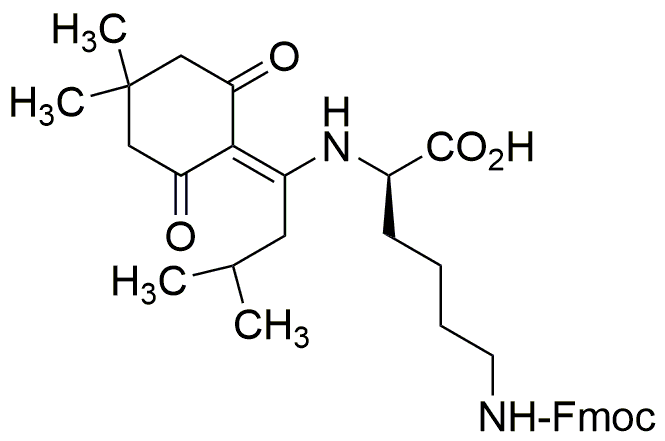Na - (4,4-Dimethyl-2,6-dioxocyclohex-1-ylidene)-3-methylbutyl- Ne -Fmoc-D-lysine is widely utilized in research focused on:
- Peptide Synthesis: This compound serves as a key building block in the synthesis of peptides, particularly in solid-phase peptide synthesis, enhancing the efficiency and yield of desired products.
- Drug Development: Its unique structure allows for the design of novel pharmaceutical agents, particularly in the field of cancer research, where modifications can lead to improved efficacy and reduced side effects.
- Bioconjugation: The chemical is used in bioconjugation processes, enabling the attachment of biomolecules to surfaces or other molecules, which is crucial in the development of targeted therapies and diagnostics.
- Research in Protein Engineering: It aids in the modification of lysine residues in proteins, facilitating studies on protein structure and function, which is essential for understanding biological mechanisms.
- Material Science: The compound can be incorporated into polymer systems to enhance material properties, such as thermal stability and mechanical strength, making it valuable in the development of advanced materials.
General Information
Properties
Safety and Regulations
Applications
Na - (4,4-Dimethyl-2,6-dioxocyclohex-1-ylidene)-3-methylbutyl- Ne -Fmoc-D-lysine is widely utilized in research focused on:
- Peptide Synthesis: This compound serves as a key building block in the synthesis of peptides, particularly in solid-phase peptide synthesis, enhancing the efficiency and yield of desired products.
- Drug Development: Its unique structure allows for the design of novel pharmaceutical agents, particularly in the field of cancer research, where modifications can lead to improved efficacy and reduced side effects.
- Bioconjugation: The chemical is used in bioconjugation processes, enabling the attachment of biomolecules to surfaces or other molecules, which is crucial in the development of targeted therapies and diagnostics.
- Research in Protein Engineering: It aids in the modification of lysine residues in proteins, facilitating studies on protein structure and function, which is essential for understanding biological mechanisms.
- Material Science: The compound can be incorporated into polymer systems to enhance material properties, such as thermal stability and mechanical strength, making it valuable in the development of advanced materials.
Documents
Safety Data Sheets (SDS)
The SDS provides comprehensive safety information on handling, storage, and disposal of the product.
Product Specification (PS)
The PS provides a comprehensive breakdown of the product’s properties, including chemical composition, physical state, purity, and storage requirements. It also details acceptable quality ranges and the product's intended applications.
Certificates of Analysis (COA)
Search for Certificates of Analysis (COA) by entering the products Lot Number. Lot and Batch Numbers can be found on a product’s label following the words ‘Lot’ or ‘Batch’.
*Catalog Number
*Lot Number
Certificates Of Origin (COO)
This COO confirms the country where the product was manufactured, and also details the materials and components used in it and whether it is derived from natural, synthetic, or other specific sources. This certificate may be required for customs, trade, and regulatory compliance.
*Catalog Number
*Lot Number
Safety Data Sheets (SDS)
The SDS provides comprehensive safety information on handling, storage, and disposal of the product.
DownloadProduct Specification (PS)
The PS provides a comprehensive breakdown of the product’s properties, including chemical composition, physical state, purity, and storage requirements. It also details acceptable quality ranges and the product's intended applications.
DownloadCertificates of Analysis (COA)
Search for Certificates of Analysis (COA) by entering the products Lot Number. Lot and Batch Numbers can be found on a product’s label following the words ‘Lot’ or ‘Batch’.
*Catalog Number
*Lot Number
Certificates Of Origin (COO)
This COO confirms the country where the product was manufactured, and also details the materials and components used in it and whether it is derived from natural, synthetic, or other specific sources. This certificate may be required for customs, trade, and regulatory compliance.


